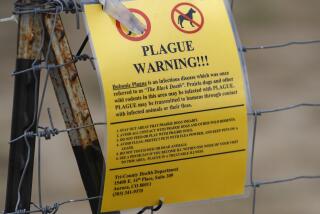EPIDEMICS AND HISTORY: Disease, Power, and Imperialism.<i> By Sheldon Watts</i> .<i> Yale University Press: 384 pp., $35</i>
- Share via
Picture yourself a 14th century Jewish moneylender. You live in Strasbourg, near the River Rhine, the major north-south waterway of medieval Europe. In keeping with reforms of the Fourth Lateran Council, you wear distinctive clothing mandated by local Christian clerics. Forbidden to cultivate land, you and your kinsmen are peddlers, merchants, bankers and, sometimes, medical practitioners. The high rate of literacy among Jewish boys and men, combined with access to ancient scientific knowledge through Hebrew and other Middle Eastern texts, has branded your already visible clan with rather suspicious intelligence. At least so think certain priests, townsfolk and neighboring peasants, the ones who whisper furtively behind their hands when you pass in the road.
Then comes the ill-fated summer of 1347. Genoese merchant ships visiting Black Sea ports pick up unsuspected cargo: rats and fleas infected with bubonic plague. Plague, that sickle-bearing herald of Heaven and Hell, first sails through the Dardanelles, then touches down at Messina, Sicily, and from there travels to Pisa, Genoa, Marseilles. Soon it moves inland, and wherever it moves, it is like no other miasma previously known to Europe’s then-semiautonomous towns. It is indeed a ghastly punishment from God and, by 1351, it killed three out of 10 people on the continent.
Now let us return to Strasbourg and St. Valentine’s Day, 1349. Although the town has not yet witnessed the suppurative agonies of the plague, the disease is rumored to be nearby. How can the town keep it at bay? Perhaps a religious processional to appease an angry deity? Yes, and by all means, rid the town of the unclean and unfaithful. And so, as you study your ledger and count coins by flickering candlelight, there is a knock at your door. Before you realize what is happening, the magistrates’ men have scuffled you to the earthen floor. Now they have you securely locked by the arms, and they lead you to the town square. There is a giant bonfire; you are dumbstruck with fear and horror--there are bound men of your own ethnicity being thrown into the flames. Your last memory? Perhaps, through ghoulish, leaping shadows, the rapt faces of cretinous onlookers who, you dazedly realize, will no longer have unpaid debtors’ notes among their daily worries.
In 1349, 900 Jews were burned alive in Strasbourg in a desperate attempt to stave off the Black Death. Of course, when the plague finally hit Strasbourg later that year, it struck down Jews and Christians alike. With this evidence safely in hand, Pope Clement VI disowned the anti-Semitic “experiment” and roundly condemned the slaughter of the Hebrews.
Grisly and ironic installments from the archives of medicine are the signature of “Epidemics and History,” which is, in short, a chronicle of pestilence. Plague is the linchpin, followed by leprosy, smallpox, syphilis, cholera and the dual mosquito-borne menaces imported to the New World by African slaves, malaria and yellow fever. What these agents have in common is a sort of biologic opportunism linked to global imperialism: All were easily transmitted microbes (with the exception of leprosy, a surprisingly noncontagious infection) that traveled as lethal cargo in the era of seaborne exploration, trade and conquest. What else links these diseases? According to author and social historian Sheldon Watts, all served as serendipitous, and in some cases purposeful, vehicles for Western domination over the world’s tropics and oppressed peoples.
This is a daunting thesis to defend, but Watts works hard to make his case. Outlining the record of Western imperialism is the easy part. Connecting the imperialists’ success to the importation and spread of infectious diseases is more of a stretch. Watts is blatant in at least one agenda: In six densely referenced chapters, each anchored to a single affliction, he presents a hypothesis (which he terms a “construct”) ultimately critical of then-prevailing Western attitudes and practices toward the disease in question.
In the case of plague, Watts contrasts injustices of the West (where, indeed, involuntary quarantine in pesthouses may have killed more healthy than sick individuals) with the more humane plague proscriptions of the Muslim Middle East. Lepers are presented as victims of a continuing legacy of Judeo-Christian stigmatization that has branded them morally impure from the Middle Ages to present day. Twenty-eight million deaths caused by cholera during the British rule of India (1786-1947) cannot be wholly blamed upon colonials. Still, Watts is quick to remind us that some pukka sahibs likened cholera to a Malthusian instrument of population control. They also saw filthy water and raw sewage as natural elements of low-caste Indian life, thus hindering desperately needed sanitary engineering.
Syphilis, known as “plum tree poison” when it finally arrived in China by way of the Americas and Europe, becomes Watts’ pulpit for preaching the ills of Western sexuality. With ricochet logic that falls barely short of editorializing, he alleges that sexual neurosis, double standards between the genders and Puritanism created a fertile field for illicit sex and STD transmission in the West. In contrast, the East, blessed with enlightened Taoist teachings, embraced an earthier, healthy sexuality until missionaries brought ashore their contaminating concepts of guilt and sin.
Despite Watts’ aversion to Eurocentric scholarship, his mastery of six centuries of Western-influenced infectious disease and sanitation history is impressive. He also writes with authority about the pre-modern and modern medical profession. Before the 17th century, empirical observations were disdained by the learned elite, and university-trained medical doctors (who ranked just below theologians and jurists on the intellectual totem pole of the day) were less humanitarian than Aristotelian in their thinking. Accordingly, their passion was philosophy, as opposed to the care of living, breathing creatures in the throes of some loathsome infectious attack. The alternative practitioners (precursors of today’s doctors) were the empirics, considered, in Watts’ words, “low status hacks.” Ordinary unlettered people (95% of the population) had virtually no interaction with medicine at all. No wonder they saw demons and wandering souls as the principal agents behind catastrophic epidemic disease.
Readers of “Epidemics and History” will certainly feel pain and indignation, in particular when reliving such infamous episodes as the “gift” of smallpox-infested blankets by British General Sir Jeffrey Amherst to Native Americans or the sacrifice of innocents in Strasbourg. This same pain and indignation has motivated an especially passionate book. But the outrage shared by author and reader should be tempered with realism. One need not be a cynic, or even a sophisticated student of history, to know that ignorance and hysteria have always been fertile sod for amoral seekers of power. And what ignorance and hysteria abounded in the era of the great epidemics! As heirs to the near-miraculous achievements of 20th century microbiology and public health, whether we live in Western society or the tropics, we can only view with compassion the dilemma of our ancestors. All their learned theories (take, for example, the notion that the plague was caused by heating of the air caused by the planetary alignment of Saturn, Jupiter and Mars on March 24, 1345, a belief once held by the best minds of the Sorbonne medical faculty) were utter dross compared with a handful of modern antibiotics or vaccines.
More than 540 years were destined to pass between the plague’s arrival in Europe and bacteriologist Alexandre Yersin’s isolation of the causative microbe from infected rats and human disease sufferers in Hong Kong in 1894. Our etiologic understanding of the other bacterial, viral and protozoan scourges so vividly depicted in “Epidemics and History” falls within the same time frame, roughly the last 100 years. Stemming from these discoveries, at long last, came bona fide treatments.
I agree with Watts that we have not fully capitalized on this century’s microbiological enlightenment, especially in aiding residents of developing regions of the world. In one respect, I even exceed Watts’ pessimism: I believe we may yet witness the ultimate politicization of infectious disease in biologic warfare. But painful lessons of history and dark prognostications should not diminish what has already been accomplished in a mere two generations, namely the large-scale and ongoing control of infectious diseases worldwide. The dedicated and hard-working foot soldiers in this war--from village health worker to missionary nurse to research scientist--far outnumber the company of past or present imperialists who would exploit epidemic diseases to their own evil ends.






